You bought a drone for taking pictures, now what? Why don’t your photos and videos look as good as those produced by the professionals? What sort of drone camera sorcery are they using? We have scoured the internet, asked the experts, and interjected a bit of our own experience to bring you the best compilation of drone camera tips on the internet.
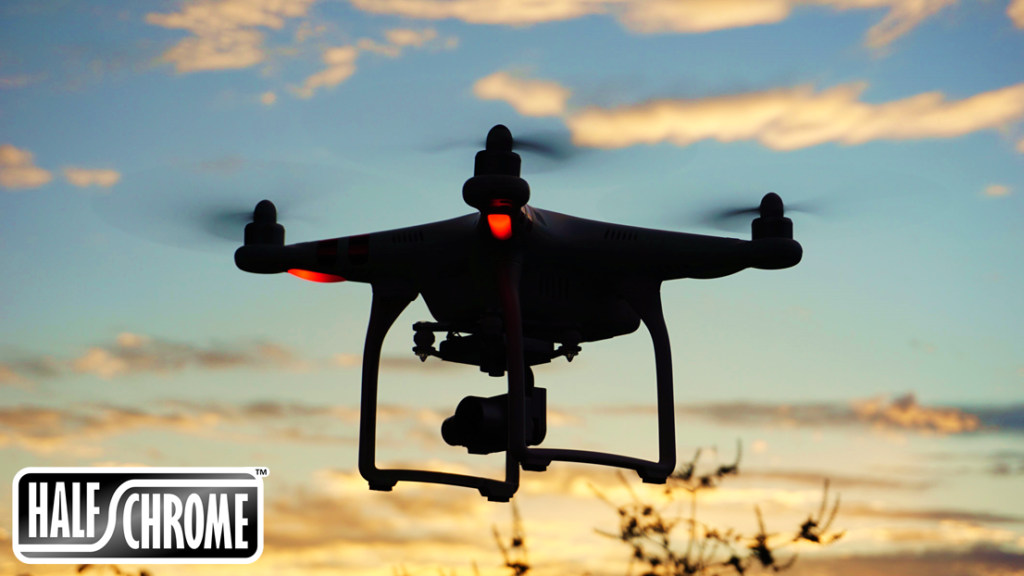
To get the most out of your drone you will need the right equipment, the right settings, the right techniques, and the right subject. Follow our tricks and create aerial photography magic. At the end of the article we even provide a pre-flight checklist because, if you are like us, you are forgetful from time-to-time. We want to make sure you fly safely and get the perfect pictures.
Special thanks to Chinavasion for providing some of the tips as well as photos for the article. Chinavasion has some great deals on drones, accessories, and other gadgets. Check them out here. We’ve searched the web for other great how-to fly articles. Check this one out from Jen’s Reviews.
Equipment – Every Magician Needs a Good Wand
To get the best aerial shots you will need some decent tools. Here is what we recommend.
Three-Axis Gimbal: With few exceptions, every great drone photograph since the beginning of drones has been taken with a camera mounted on a 3-axis gimbal. Since the release of the DJI Spark, that paradigm has changed a little, but the best stuff still comes from a 3-Axis gimbal. Prosumer drones with 3-axis gimbals include the DJI Phantom 3 and 4 series, the DJI Mavic, the Yuneec Typhoon, and the Autel X-Star Premium. However, our new favorite is the DJI Mavic 2 Zoom. You will definitely want to check it out.
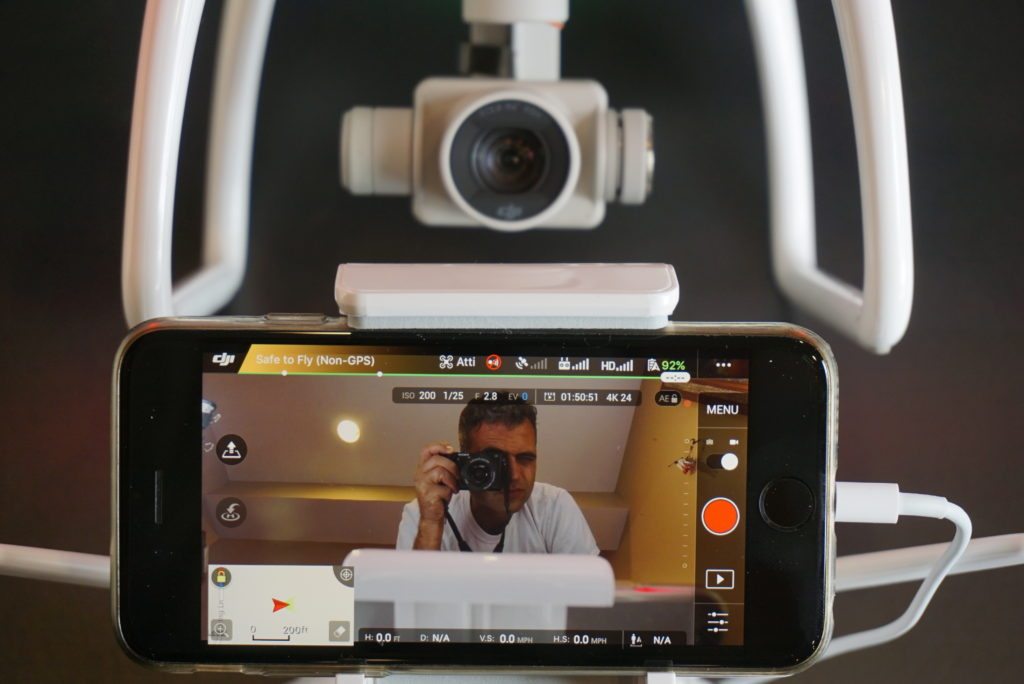
A Great Camera: This is obvious, of course. A great camera is the first step in taking great pictures. What makes a camera great? Well-designed lenses, a large high-quality sensor, and customizable camera settings are a good start. A mechanical shutter also doesn’t hurt. One of the most capable cameras on the market right now is also one of the most popular – it is the camera available on the Phantom 4 Pro and Phantom 4 Advanced. This camera has all of the features mentioned above as well as an adjustable aperture. If you want a better camera than the Phantom 4 Pro then you will need to upgrade to an Inspire.
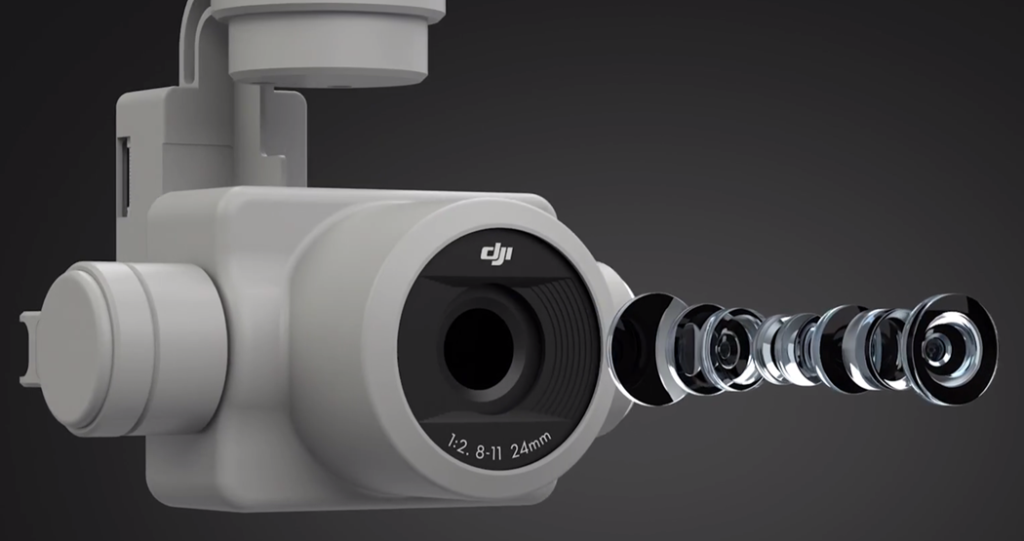
ND Filters: Neutral Density Filters are basically sunglasses for your camera. They allow the camera to take longer exposures by reducing the light that gets into the camera. This isn’t as important for drone photography as it is for drone videography. The general rule-of-thumb for video capture is that you want your shutter exposure to be half as long as the frame rate. So, if you are recording video at 30 fps (frames per second) then you will want an exposure time of 1/60 of a second.
In bright conditions, a longer exposure time can only be achieved with an ND filter in front of your camera (unless you have the P4 Pro, in which case you can slow down the camera by shrinking the aperture). Failure to slow down the exposure will produce a choppier and less cinematic video. Even worse, too high of a frame rate can introduce artifacts like “jello effect,” or rolling shutter, in your video. “Jello” is a pretty common issue. Not sure what that is? Take a look below.
Polarizing Filter: The polarizing filter is less important than an ND filter, but it can help reduce glare and improve saturation in many situations. Make sure you can line up the orientation of the polarizer appropriately. Mark the correct orientation on the filter. If the filter is threaded onto the drone’s camera then you may not be able to completely tighten the filter in place in order to get the correct orientation. Bring some tape to keep the filter oriented correctly and to keep it from shaking off the camera.
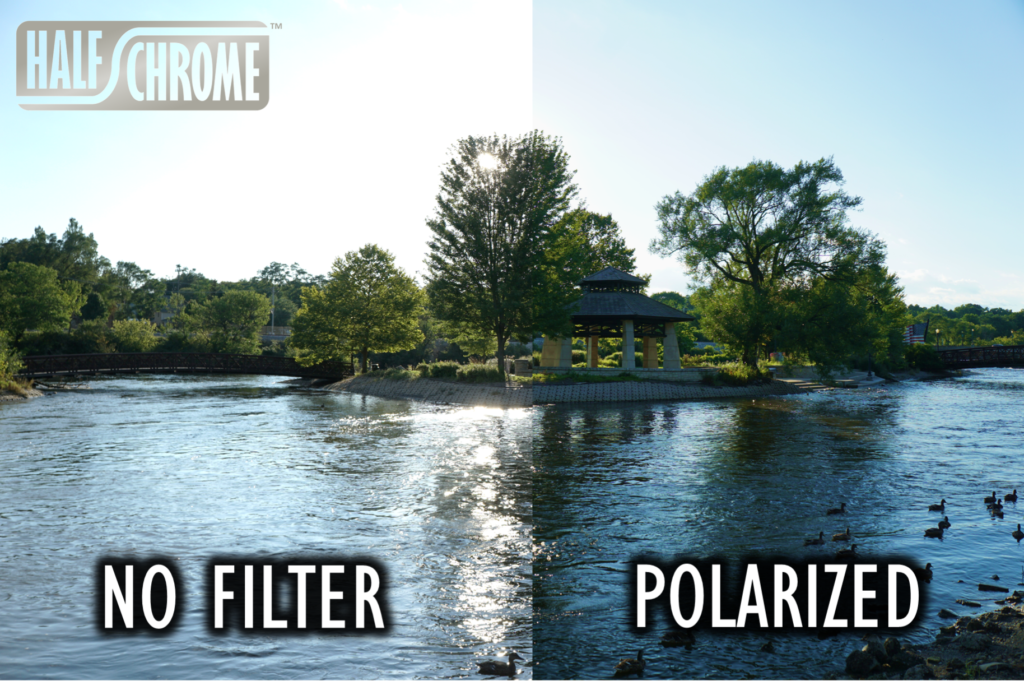
Balanced Propellers: An unbalanced propeller is a propeller where the center of mass is not on the rotational axis of the propeller. When you fly with even one unbalanced propeller the drone will vibrate much more than it otherwise would. The extra vibration can decrease the sharpness of photographs and add jello effect to your videos. Unfortunately, even OEM propellers may not come properly balanced. To check the balance of a propeller you will need a prop balancer, we like this one.
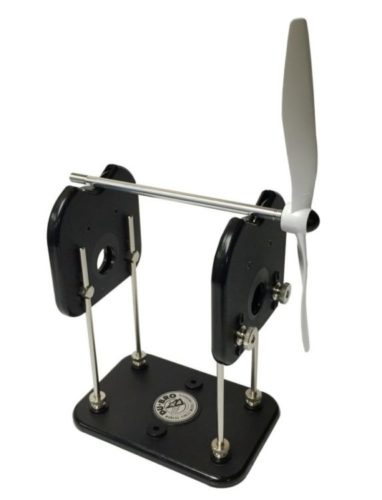
The best way to adjust the balance is to use some medium-fine sandpaper to remove some weight from the heavier side of your propeller. Folding propellers, like those on the DJI Mavic and DJI Spark, are not as easy to balance.
Fast Memory: If you want the best content you will be recording RAW (more on that later). Recording uncompressed photos is memory intensive. We recommend only the fastest SD cards. Fast cards, like the Sandisk Extreme Pro, will also perform the most reliably when recording high-speed video (faster than 30 fps) or 4K video.

Support Equipment: Getting your drone setup properly is the first step, but you probably want some backup.
- Extra props: Maybe your Phantom tips over on landing and you dent a prop. Time for a new one. Make sure you don’t leave your spares at home.
- Extra batteries: A 20-minute flight is frequently not enough. You should have at least 3 batteries for your drone.
- Multiple memory cards: Some people recommend changing your card every time you change the battery. If you follow this advice then you won’t lose a whole day’s work if your card malfunctions.
- Backup memory: Pros backup their content early and often. Bring along some portable memory for saving your valuable content. We recommend the Seagate Seven 500GB drive. It is thin for easy transport and it has a proven track record of reliability.
- Accessible storage: A great carrying case will protect your valuable aircraft and get you airborne quickly and efficiently. Features you may want to consider are ease of carrying on an airplane (the kind you fly in), water proofing, and storage for accessories.
Camera and Drone Settings – Polish Your Wand
The best camera drones have plenty of customization available. If you want the best photos and videos then you will need to learn some of these settings.
Slow Down the Drone: Specifically, you want to change the settings related to drone yaw rate and the gimbal pitch rate. To experience why you need to do this just try to capture a 1-minute video while adjusting the camera angle as slowly as you can. You will be disappointed with the default settings. High-end drones like the Phantom 4 Pro allow you to customize these settings. On consumer drones, like the DJI Spark, you may need to go into “tripod mode” to slow down these controls, but that also slows down your flight speeds.
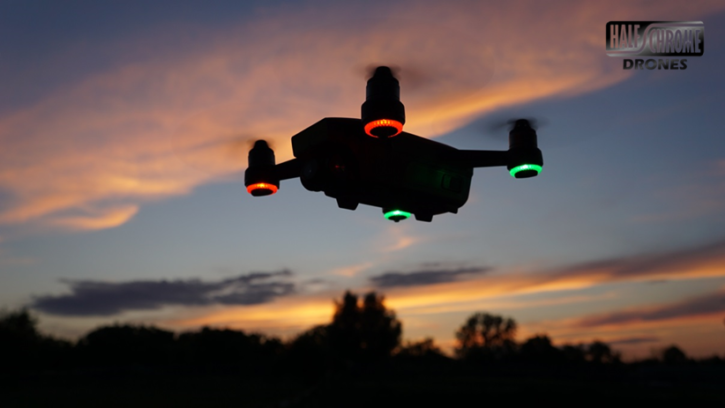
Capture RAW Photographs: RAW images contain all the original information from the photograph, they are not compressed like a JPEG. Because none of the information is missing, these images are far superior for editing, particularly for color and dynamic range correction. RAW images are much larger in size and they take longer to save to memory (that’s why fast memory helps). Stock up on memory and go RAW!
AEB (Auto Exposure Bracketing): Setting the correct exposure in a picture is not always easy, especially when you are using a smartphone screen drenched in sunlight as your gauge for what the picture is going to look like. When you use AEB the drone will take several photos at different exposure levels. One of them is likely to be what you were hoping for. Another reason to use AEB is so that you can create HDR (high dynamic range) images in post processing by combining 2 or more images taken with different exposures. The human eye has a larger dynamic range than even the best image sensors, so use HDR to better capture details in the dark parts of your pictures.
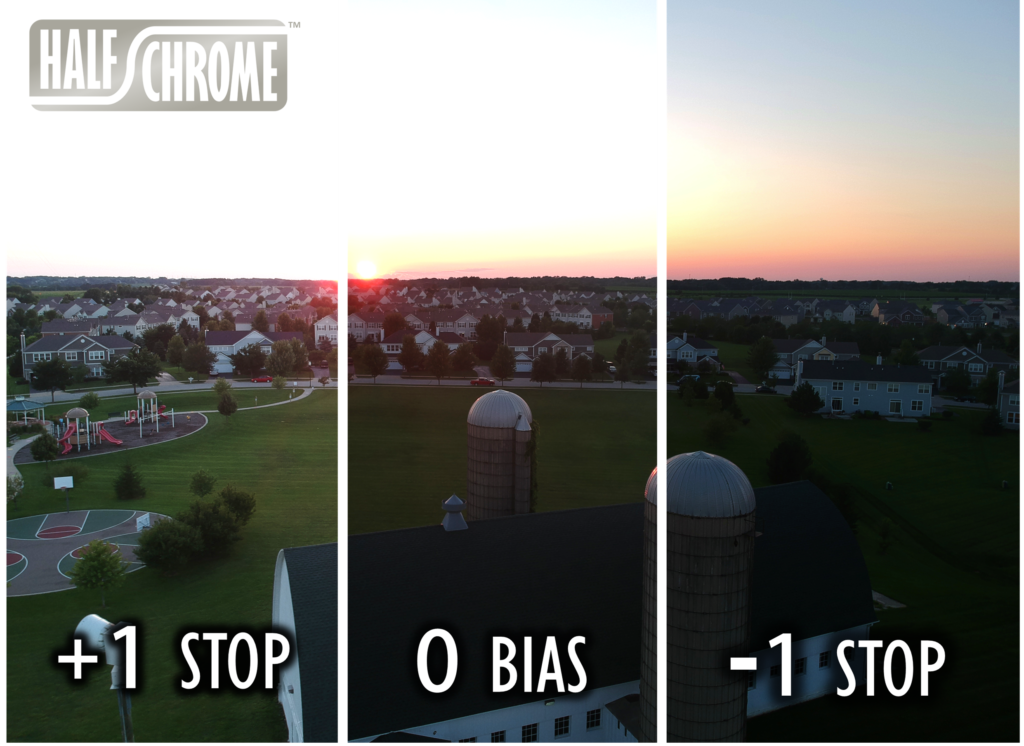
Manual Camera Settings: The best pictures are taken at the lowest ISO speeds. Manually lower the sensitivity to ISO 100 whenever possible. With a 3-axis gimbal, you can safely go to shutter speeds as low as ⅙ of a second pretty safely. In some low-wind situations with a well-calibrated drone, you can even take exposures as long as 3 seconds without adding much blur. Take a few pictures and you can pick the one that happened to have the least camera motion during the exposure.
Check your Video Shutter Speed: As discussed above, use ND filters to achieve a shutter speed that is half of your frame rate when recording video.
Hone Your Skills – It’s the Magician, not the Wand!
A well-polished setup never hurts, but ultimately the pilot’s skill is what sets them apart from the crowd. The most interesting shots follow this one simple rule: Capture with a drone what you can’t capture from the ground. Your images will stand out more if you are able to create a unique perspective.
Birdseye View: Looking straight down is a view historically limited to birds and helicopters. You can’t get this view from a tripod and it’s even difficult from a plane. The birdseye view seems to show up in more award-winning drone photos than any other angle. For video, you can move along in a line for a reveal or spiral as you ascend for a unique effect.
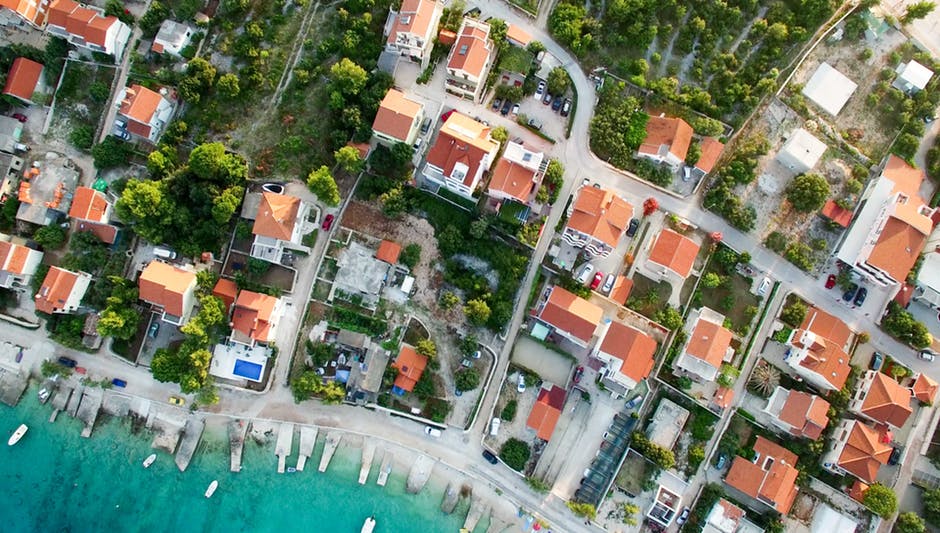
Photography Tips
We have already covered several tips in the equipment and setup discussions, but we have one more tip to the uninitiated…
The rule of thirds: This simple rule is followed by artists and photographers everywhere. The principle is simple, just position the focal point of the picture and a point in the image that is ⅓ of the way from both edges of the frame. There are other times when you will want to center your subject, but the rule of thirds is a tried and true strategy to create intriguing images.
Turn on the Grid: We suggest turning the ⅓ grid on if your drone provides this option. This allows you to better align shots and position subjects in accordance with the rule of thirds.
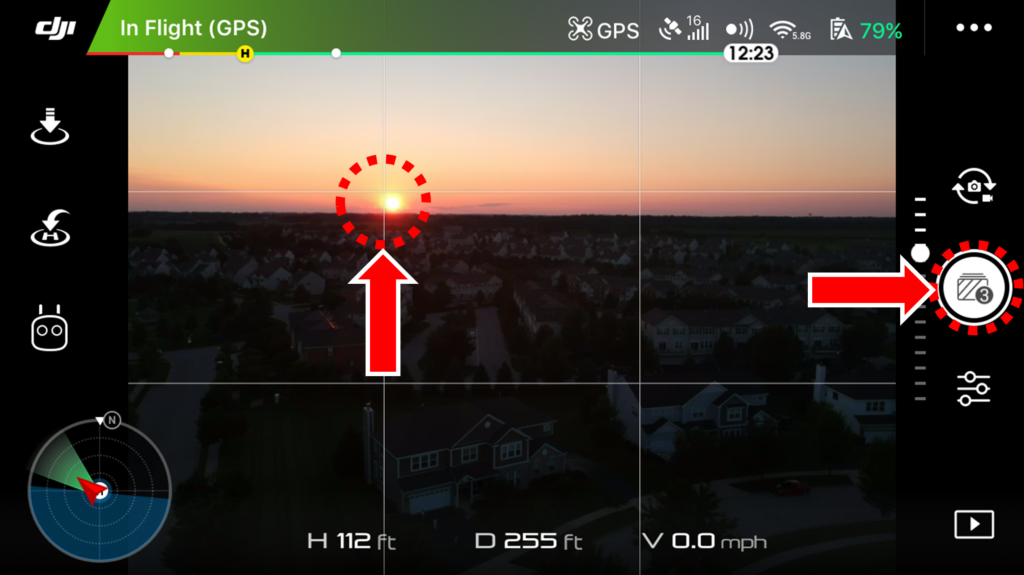
Videography Tips
There are a few general videography tips that apply to all shots.
Fly through your shots: This means maintaining a course with your drone that starts before and after the section of the video that you want to keep. This allows for easier editing and the possibility of adding effects like fading between shots in post-production.
Plan for Short Video Clips: A well-edited video typically stays with a single scene for no longer than 5-10 seconds in order to maintain visual interest. Adjust your scenes accordingly. Watch the clip by DJI below as they transition from scene to scene rather quickly.
Slow Down: Make small adjustments on the controls, particularly with yaw and camera pitch. As we mentioned above, you will want to dial these setting down as well if your drone offers that as an option.
Now Speed Up: Even the best and most stable drones shift around a bit due to the wind and GPS accuracy. If you fly very slowly and then speed up video in post production then your video can look very jittery. The video below is an excellent example. The Spark was flying slow. Solve this by flying fast! The drift of your camera will be far less noticeable when moving at fast speeds. Record at 60 frames per second and slow down the video in post production. The video of the Spark below was done in tripod mode, meaning the Spark was moving very slowly. You can see when the video is sped up (at 0:30) it looks a little jittery.
Video Wizardry – Learn Some Expert Videography Moves
Once you know the basics it is time to practice some expert shots. Dollys, orbits, fly-throughs, and corkscrews. Active track, helixes, rockets, and reveals. There are a lot of moves and advanced functions you can use – practice makes perfect.
Make Your Drone A Dolly
A dolly is a standard tool used in making professional videos. Basically, it is just a camera on wheels, riding on a track. Dollys are used to get closer or further from a subject or to slide sideways. This is actually a really trivial thing to do with a drone. The newest drones from DJI (Mavic, Phantom 4 Pro, Spark, and Inspire 2) are the most stable drones on the market and will be the best at simulating a dolly.
This short video shows us demonstrating some pretty simple flight patterns as well as a couple slightly more complex movements including changing altitude while adjusting the gimbal angle.
Of course, your drone dolly can go much higher than a standard dolly. From up high, the positional instability of your drone will not be as noticeable, especially when flying at high speed. Linear motions are not only the easiest with a drone, they are also one of the most commonly and successfully used flight paths.
Learn More Moves by Watching the Pros
We like learning about the interesting camera and drone motions by learning from experts who show us how to do it. We love the series by Alina and Stewart Carroll from Drone Film Guide brought to you by Scottish film production company Captain Cornelius. With his wonderful accent, this Scotsman provides great pointers, showing you how to get the most out of your camera drone. You can check out their website or see more of their YouTube channel.
Time and Place for Aerial Magic – Know When and Where to Fly Your Camera
The subject of your aerial footage is critical. Scout out interesting locations ahead of time. If you are like us, and you are stuck in corn country, then you may be a little disappointed. You may think you don’t have access to the best locations. Fear not, some award-winning photographs have come from nothing more than a corn field viewed from a unique perspective. So when life gives you lemons, go fly your drone.
Map It: Google Maps is your friend for scoping out locations. Its satellite images can see most of the things your drone can. You will still need to scout for obstructions like power lines and towers later when you are on-location.
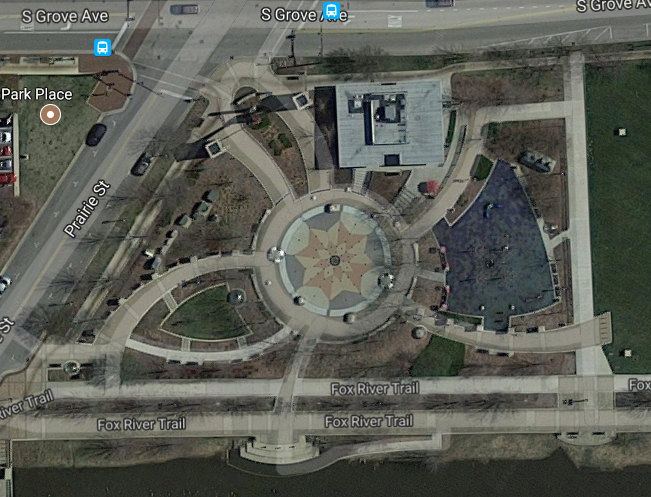
The Golden Hour: One hour after sunrise and one hour before sunset is a great time to capture aerial images. The sky is lit up with warm yellow hues.
The Blue Hour: One hour before sunrise and one hour after sunset is known as the blue hour. Like the golden hour, this is a good time for colorful shots. Don’t fly more than an hour outside of daylight, the FAA doesn’t like that. Check your local regulations.
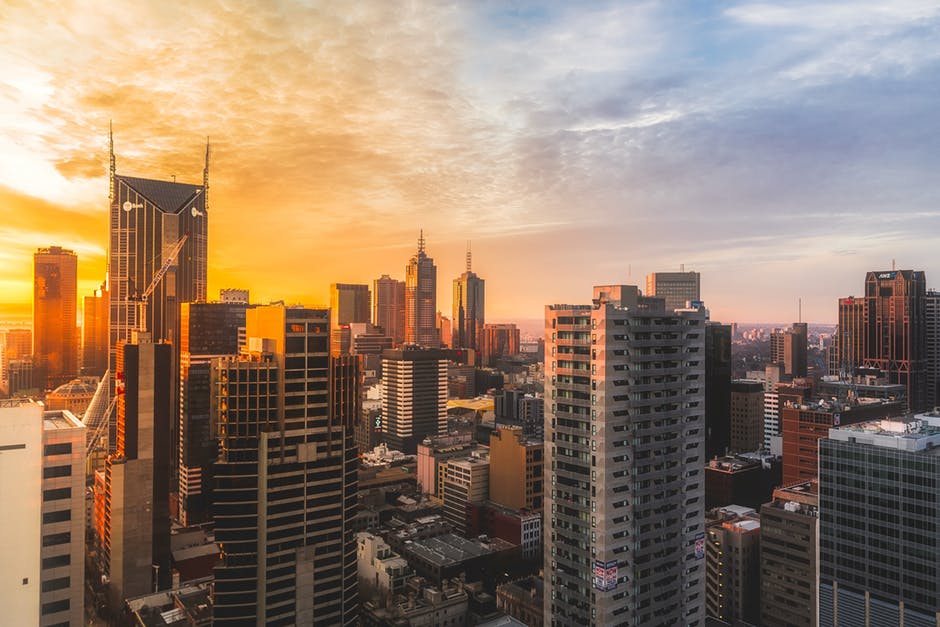
Weather: This is pretty simple, rain, wind, and snow are not your friends. The wind will affect the quality of your images and video and high winds can make it difficult or (gulp) impossible to bring your drone home. Water and melted snow will damage your drone unless you have a waterproof drone.
Temperature: In the cold, your drone’s battery life will be dramatically diminished. Some advanced drones have heaters to help mitigate this. Some smartphones (iPhone 6) have a propensity to shut off in sub-freezing weather as well, so be careful if your smartphone is your FPV screen. Extreme heat can also be hard on drones and smart devices. Some smart devices (iPad) will overheat and shut down in the hottest climates.
Solar “Weather”: It turns out that mother nature isn’t the only thing you need to track. When the sun gets excited your drone’s ability to lock on the GPS signals may diminish. The Kp index is a measure of geomagnetic disturbance. A Kp of 5 or more can spell trouble for your drone. Track Kp as well as wind and weather conditions at our new favorite website, UAVforcast.

Fly Legally: You don’t want to be hit with a large fine or have your thousand-dollar drone confiscated. Know the law where you are flying. Most importantly, stay out of restricted airspace. You don’t want to endanger air travel or end up on the 5 o’clock news. If you are flying commercially in the United States (getting paid for your photos or videos) then you’ll need to pass the remote pilot exam and get your self a part 107 license. We have an extensive guide on how to get that done here.
The Drone Wizard’s 18-Point Preflight Checklist
Safety is one concern, not losing your footage is another. Read on for a complete list of things to check before you fly.
- Before you Power on the Drone:
- Follow the manufacturer’s preflight checklist
- Check the wind, temperature, precipitation and solar radiation conditions. Your one-stop-shop for information is UAVforcast.
- If you are flying near water make sure you are prepared. Most drones and water do not mix. High-tech waterproof drones are coming, but there are only a handful on the market right now.
- Make sure you are flying legally. DO NOT fly in restricted airspace. Watch the time of day, flying at night is illegal.
- Scope out the location. Look on Google Maps. Plan your flight paths and look for obstructions. This is extremely important. Check out these tips from our favorite Scotsman and his lovely wife.
- Do you have the right lens filter on your camera for your situation? ND filters are recommended for videography in brightly lit conditions.
- Is your memory card installed? Is it a fast enough card for what you are recording? Faster and larger capacity cards are recommended for RAW photography and 4K or 60 fps videography.
- Are your gimbal and lens protector removed?
- Are batteries for the remote and drone charged adequately?
- After Powering the Drone
- Calibrate the compass.
- Check gimbal settings to make sure they are tuned down for videography
- Check camera settings before the flight to reduce wasted battery life while you fiddle with settings in flight.
- Check that your RTH (return to home) altitude is sufficient for nearby obstructions.
- Don’t forget to hit “Record.” There is nothing worse than completing the world’s greatest camera motion only to discover you didn’t hit record.
- After Flight
- Stop any ongoing video recordings
- Power down the drone and remove the battery from the drone
- Backup your footage on an external hard drive
- Put a fresh card and battery in the drone.
- Repeat.
Sure, this is a lot of information. You don’t have to master all of these tips in one read. Throw a bookmark on this page and come back again. If you want some help picking out the perfect drone for all of this work then check out this article. Good luck and happy flying.
Disclosure:
This website contains affiliate links, which means we receive a commission if you make a purchase using these links. For full details visit the disclosures and disclaimers page.

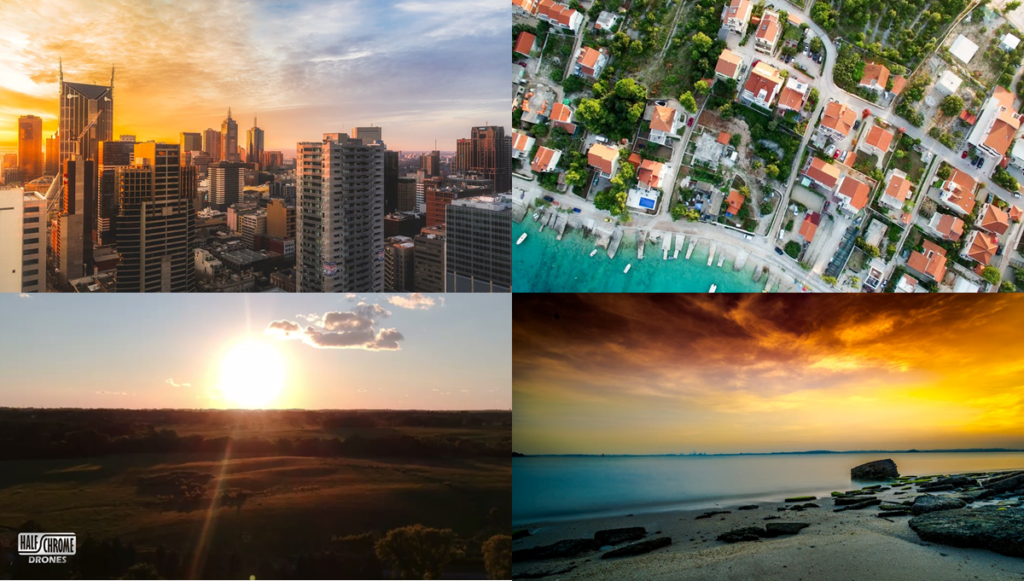

Pingback: Best Drones Now - Half Chrome Drones
Pingback: Virhuck GB202 Nano Drone: This is a tiny but fun little quad.
Pingback: Phantom 3 SE or Phantom 3 Standard: Which is Better? - Half Chrome Drones
Pingback: Drone + 360° Camera = Awesome - Half Chrome Drones
Pingback: Eachine E52: A Portable Selfie Drone - Half Chrome Drones
Pingback: DJI Mavic Standard: The Affordable, Portable Drone - Half Chrome Drones
Pingback: The DJI Mavic 2: What to expect from DJI's next game-changing drone
Pingback: MJX Bugs 2: The Versatile Bugs 3 Gets an Upgrade - Half Chrome Drones
Pingback: DJI Spark 2- The New Spark Pro Will Impress You
Pingback: Spark vs Phantom 3: Which is Better for YOU?
Pingback: EMAX BabyHawk: The Smallest and Most Agile Hawk Out There
Pingback: C-Fly Obtain: Is This the Closest Thing to an Affordable Mavic?
Pingback: HiteHome 16011: The Safe Blimpy Quadcopter: - Half Chrome Drones
Pingback: JJRC H37 Baby Elfie: An Affordable HD Selfie Drone
Pingback: DJI Osmo Mobile: Make Some Magic - Half Chrome Drones
Pingback: Force1 F100: A Sleek and Powerful Brushless Motor Drone
Pingback: DJI Mavic Pro Platinum - Half Chrome Drones
Pingback: DJI Updates 3 Drones Today! Mavic, Phantom and Spark Get Better - Half Chrome Drones
Pingback: Phantom 4 Pro: Is This the Best drone on the Market Today? - Half Chrome Drones
Pingback: DJI Rumors: What's Coming Next? - Half Chrome Drones
Pingback: Syma X5UW Altitude Hold FPV Drone Under $100 - Half Chrome Drones
Pingback: Force1 Thunderbolt: A Top Beginner Drone with Features Galore!
Pingback: UDI Discovery 2: The Upgraded 818A - Half Chrome Drones
Pingback: Force1 U49C Red Heron: A Beginner Drone with an HD Camera - Half Chrome Drones
Pingback: MJX Bugs 9: An Entry into FPV Flight - Half Chrome Drones
Pingback: MJX Bugs 8: A Ready To Fly Racer for Beginners
Pingback: Mini Beetle Pocket Drone: Compact, Portable, Fun and Under $20
Pingback: Syma X8 Pro - Half Chrome Drones
Pingback: Get a Great Deal on Accessories for Your DJI Spark
Pingback: FatShark Killers: The Eachine EV100 and Furibee FB100 - Half Chrome Drones
Pingback: Flying3D YL919 Reaper: Is This the Best Beginner Drone on the Market?
Pingback: JJRC H49: The Thinnest Selfie Drone You Can Buy
Pingback: Hubsan H122D: A New Compact FPV Flyer for Beginners
Pingback: Parrot Bebop 2 Power - Half Chrome Drones
Pingback: Walkera Rodeo 110: A FPV Solution for Beginners
Pingback: Christmas Themed Drones to Stuff Your Stocking
Pingback: Force1 U45W BlueJay: Rule the Roost with this Drone
Pingback: Hubsan H501M: Hubsan Upgrades their GPS Quad with Waypoints
Pingback: Eachine E56: A Selfie Drone That Looks Like a DJI Spark.
Pingback: DRL Race Vision 220 FPV Pro: Your Gateway Drone to Racing
Pingback: The DRL Air Elite 115 is One of the Best Starter Quads You Can Buy
Pingback: The Dobbin: Not to be Confused with the Dobby Selfie Drone
Pingback: GearBest Deals - Half Chrome Drones
Pingback: Furibee H801: WiFi FPV Tiny Whoop with an HD Camera
Pingback: JJRC H48: The Little Chubby... Yes, Really..
Pingback: JJPRO X3 HAX: A GPS Drone with an HD Camera? Yes, Please...
Pingback: DJI Mavic Propeller Test: Is the New Platinum Prop Worth It?
Pingback: These are the Best Drones for Kids in 2017
Pingback: The Jumper T8SG: The Universal Remote for Drones
Pingback: RedPawz R010: A Ducted Tiny Whoop with Zip
Pingback: Eachine Q90C: Is This the BEST All-in-One FPV Package You Can Buy?
Pingback: Furibee DarkMax: A Powerful Lightweight Racer
Pingback: Save up to 50% this Black Friday on Drones - Half Chrome Drones
Pingback: Half Chrome Drones: Free Drone Giveaway - Half Chrome Drones
Pingback: The NEW DJI Mavic Pro Alpine is one good looking drone!
Pingback: Tiny Whoopin' for the Christmas Season with the E011C and H67
Pingback: New: DJI Goggles RE (Race Edition) - Half Chrome Drones
Pingback: Is it inevitable that DJI creates a Race Drone? Yes it is!
Pingback: Brushless Micro FPV Quads: What's the Big Deal?
Pingback: DJI Spark vs Mavic: Which one is the best drone for you?
Pingback: 19HW: A Good Looking Spark Clone - Half Chrome Drones
Pingback: Cyber Monday Drone Deals - Half Chrome Drones
Pingback: Force1 Halo 3000: An Awesome Beginner Drone with a Hidden Feature
Pingback: Create Beautiful Light Paintings With a $50 Drone - Half Chrome Drones
Pingback: DJI Phantom X: Fact or Fiction? - Half Chrome Drones
Pingback: Cheerson CX-OF: An Optical Flow Micro Drone - Half Chrome Drones
Pingback: MJX Bugs 3 Mini - Half Chrome Drones
Pingback: DM IN107S: Another Spark Clone - Half Chrome Drones
Pingback: RC Logger Xtreme V2: The Best All-in-One FPV Option You Can Buy
Pingback: Turbowing Cherokee Whoop 95S: A Ducted Quad with FULL ACRO
Pingback: Drones Make Great Gifts: This Will Help You Pick the Perfect One
Pingback: What is the BEST drone under $200? Let's find out!
Pingback: Holy Stone HS200: A Top-Selling Amazon Drone
Pingback: Holy Stone F181C F181W: Two Popular Amazon Drones
Pingback: DJI Is Building a 360° Camera Drone, When Will We See It?
Pingback: Attop XT-1: It Sure Looks Like a DJI Mavic. How Does it Compare?
Pingback: Eachine QX95S: Serious Upgrades to a Micro Quad
Pingback: Is this Drone a Realtor's Worst Nightmare? - Half Chrome Drones
Pingback: Save 20% On Force1 Drones Until Christmas - Half Chrome Drones
Pingback: Will GoPro Build a Waterproof Drone? Here is How They Can Do It.
Pingback: What is the Best Drone Under $500 for 2017? We put 6 drones to the test.
Pingback: Emax BabyHawk-R Race Edition - Half Chrome Drones
Pingback: FatShark101: An All-in-One Package from a Name You Trust - Half Chrome Drones
Pingback: GoolRC G90 Pro Brushless FPV Micro Quad - Half Chrome Drones
Pingback: Cheerwing Syma X5SW V3: A Solid Beginner Drone - Half Chrome Drones
Pingback: Flight Test: Hubsan H122D - Half Chrome Drones
Pingback: Is This the Best GPS Drone Under $200?: Hubsan H501S
Pingback: MJX Bugs 3 H - Half Chrome Drones
Pingback: Bugs 3 Pro: GPS capable! - Half Chrome Drones
Pingback: Bugs 5W: GPS, Gimbal, FPV and more... - Half Chrome Drones
Pingback: MJX Bugs 10 H: A New Altitude Hold Addition to the Bugs Fleet - Half Chrome Drones
Pingback: Two Drones are Better Than One: JJRC H345 - Half Chrome Drones
Pingback: Z8W 720p: A Boxed Flyer with an Ultra Wide Field of View
Pingback: Furibee X215 Pro: An Awesome RTF Race Kwad
Pingback: Say Hello to the DJI Tello! - Half Chrome Drones
Pingback: Yuneec Typhoon H Plus, Firebird FPV and HD Racer - Half Chrome Drones
Pingback: Autel Evo: The DJI Mavic Killer
Pingback: GoolRC T36S - Half Chrome Drones
Pingback: Furibee H815 - Half Chrome Drones
Pingback: DJI Mavic Air: The New Quad is Will Be Awesome (Think Small...)
Pingback: Eachine M80S: This is the ULTIMATE Beginner FPV Quadcopter
Pingback: DJI Mavic Air vs the Spark, Battle of the Compact Quads (Which is Best?)
Pingback: DJI Mavic Air: Predictions - Half Chrome Drones
Pingback: DJI Mavic Air vs the DJI Mavic Pro Platinum (Which Is Best For YOU?)
Pingback: Mavic Air vs Autel Evo: Battle of the Portable 4K Drones
Pingback: Diatone 2018 GT-R90: There's a Full-Sized Beast Hidden Inside This Micro
Pingback: Ryze Tello vs Parrot Mambo: Which One Should You Choose?
Pingback: Jumper T8SG Plus: The Newest and Best Multiprotocol Transmitter
Pingback: Hubsan H501S: Is It the Best sub-$200 GPS Drone? - Half Chrome Drones
Pingback: Mavic Air vs Phantom - Half Chrome Drones
Pingback: iRangeX iRX-IR8M: A Solid Multiprotocol Remote
Pingback: EDrone Black Knight Cube: An Oddball Drone (or oddcube maybe?)
Pingback: 360° Camera Drones Are Coming! - Half Chrome Drones
Pingback: Save Big on Drones From Force1 RC (Exclusive Deals!)
Pingback: Mavic Air Camera Test: How Does it Compare to the Mavic Pro and Spark?
Pingback: DJI Phantom 5: Check Out the Awesome New Features!
Pingback: At a New Low Price the Yuneec Breeze is Worth Considering
Pingback: What is the Best Drone Under $100? (We Have the Answer!)
Pingback: The JJRC H61 Spotlight: A Compact Selfie Drone with an HD Camera - Half Chrome Drones
Pingback: Drone Deals- Start Here When You Are Looking for the Best Prices
Pingback: Phantom 4 V2.0 (What Will It Be?) - Half Chrome Drones
Pingback: Evolve With Us - DJI is Set for a March 28 Announcement
Pingback: Eachine QX90C PRO: A Top-Notch Micro FPV Quad
Pingback: Eachine EV900 FPV Goggles - Half Chrome Drones
Pingback: Best Drone Under $500 (2017) - Half Chrome Drones
Pingback: What is the Best Drone Under $50? (2017) - Half Chrome Drones
Pingback: What is the Best Drone Under $50 for 2017? There are 7 contenders...
Pingback: GEPRC Sparrow FPV Racer: A 100 MPH PreBuilt Racer
Pingback: XK X520: This is the BEST Beginner RC Plane (and it's under $100)
Pingback: AEE Sparrow - Is AEE's First Selfie Drone Any Good?
Pingback: Program the Ryze Tello in Scratch (Step By Step Process)
Pingback: Eachine QX65: Upgrade Your Tiny Whoop HERE!
Pingback: JJRC H61 Spotlight: A Preview - Half Chrome Drones
Pingback: Mavic Accessories (Filters and More for the Air and Pro)
Pingback: DJI Tello Range Extended 5X! The Xiaomi MI WiFi Extender
Pingback: Ryze Tello 2: What Can We Expect To See from Ryze, DJI and Intel?
Pingback: Visuo XS809S Battle Shark: A Mean Looking Drone for Beginners
Pingback: Makerfire Shark - Half Chrome Drones
Pingback: DYS Shark Mako: An Powerful and Excellent RTF Micro FPV Quadcopter
Pingback: MJX Bugs 5W (Exclusive Sale Codes)
Pingback: Syma X5UW-D: Some New Features for an Old Favorite
Pingback: Syma X25 Pro: A GPS Drone for Under $100?
Pingback: Syma Z1: A Pocket-sized Selfie Drone
Pingback: Is the Xiaomi MiTu the Ryze Tello Killer?
Pingback: Hubsan H501M: The Best GPS Drone Under $150
Pingback: Eachine E014: Tello Stability at Half the Price
Pingback: Syma Z2: The Cylindrical Selfie Drone
Pingback: Syma Z3: A Slick Looking Folding Drone (Can It Compete with the Mavic?)
Pingback: We Found the Best Selfie Drone - Get Ready to be Surprised
Pingback: Parrot Anafi: Finally the Mavic Air Has a Worthy Competitor
Pingback: El Mejor Dron - Half Chrome Drones
Pingback: Parrot Anafi vs DJI Spark: Which Drone is Better for You?
Pingback: Parrot Anafi vs Mavic Air: Which is the Best Compact 4K Drone?
Pingback: Eachine EX2 Mini vs. MJX Bugs 3 Mini: Which is Better?
Pingback: SkyRC B6 Portable Nano Charger
Pingback: DJI Event 7/18/18: Mavic Pro 2 or Phantom 5? Or Something Else?
Pingback: 2017-2018 Scholarship Winner Announced - Half Chrome Drones
Pingback: DJI Spark vs Parrot Bebop 2 - Half Chrome Drones
Pingback: Skydio R1: This is the FUTURE of Obstacle Avoidance
Pingback: Drones in Education - Half Chrome Drones
Pingback: Yuneec Typhoon H+ vs. Original Typhoon H: Which is Best for YOU?
Pingback: Tello Remotes - Flaws, Fixes, and the Right Remote for You - Half Chrome Drones
Pingback: GoolRC X12: An Inexpensive Mavic Air Clone
Pingback: Phantom 5 Lenses - 3X Zoom Has Arrived - Half Chrome Drones
Pingback: The Flyze Jello, I Mean RedPawz R020 (Not a Ryze Tello Ripoff...)
Pingback: JXD 528: A Sub $60 GPS Drone. Is This the Tello Killer?
Pingback: DJI Mavic 2 Pro vs The Mavic Pro Platinum: Which is Better for YOU?
Pingback: The SkyStars X95 Edge: A Killer Micro FPV Quad
Pingback: DJI Mavic 2 Leaked Image: What Does it Tell Us?
Pingback: The C-Fly Dream is a DJI Spark Clone with a Two-Axi Gimbal
Pingback: Bayangtoys X22: GPS and a Full Gimbal for under $300!!
Pingback: Mavic Enterprise: The Upgraded Mavic 2 Professional
Pingback: Save Big on Drones During Amazon Prime Day! DJI, Force1 and More!
Pingback: Eachine EV200D FPV Goggles - Half Chrome Drones
Pingback: Funsnap iDol Drone - Half Chrome Drones
Pingback: Mavic Zoom - Half Chrome Drones
Pingback: The Dobby: An Affordable GPS Drone Under $200
Pingback: Visuo XS812 GPS Shark - Half Chrome Drones
Pingback: DJI Event August 23, 2018 - Half Chrome Drones
Pingback: URUAV UR65 - Half Chrome Drones
Pingback: Wingsland S6: 4K, GPS, EIS for Under $200 (Is it Too Good to Be True?) - Half Chrome Drones
Pingback: Wingsland X1: A Micro FPV Racer with Optical Flow
Pingback: Mavic 2 Fly More Kit: Is It Worth It? - Half Chrome Drones
Pingback: JJPRO X5 EPIK - Half Chrome Drones
Pingback: Simtoo XT175 Fairy Drone - Half Chrome Drones
Pingback: SJ R/C F11: A Small GPS Drone Under $160 - Half Chrome Drones
Pingback: SJ R/C Z5: A Brushed GPS Drone Under $100 - Half Chrome Drones